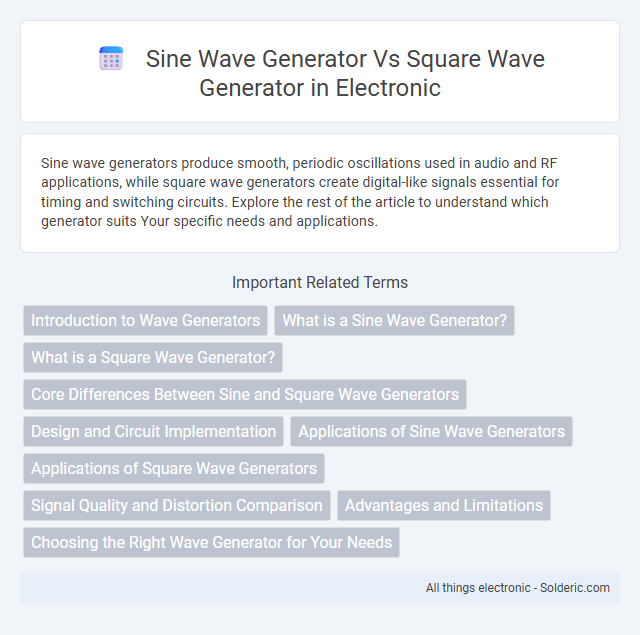Sine wave generators produce smooth, periodic oscillations used in audio and RF applications, while square wave generators create digital-like signals essential for timing and switching circuits. Explore the rest of the article to understand which generator suits Your specific needs and applications.
Comparison Table
| Feature | Sine Wave Generator | Square Wave Generator |
|---|---|---|
| Waveform Shape | Smooth, continuous sine wave | Sharp, alternating square pulses |
| Frequency Range | Low to high, stable frequencies | Wide frequency range, typically higher harmonics |
| Signal Purity | Pure fundamental frequency, low harmonic distortion | Contains fundamental and multiple harmonics |
| Applications | Audio testing, communication systems, AC power simulation | Digital circuits, clock pulses, switching power supplies |
| Output Characteristics | Analog output with smooth transitions | Digital output with rapid transitions |
| Complexity | More complex circuit design | Simpler, cost-effective design |
| Power Consumption | Moderate | Typically lower |
Introduction to Wave Generators
Wave generators produce electronic signals with specific waveforms, such as sine waves and square waves, essential for testing and signal processing in various applications. Sine wave generators create smooth, periodic oscillations ideal for audio, communication, and analog electronics due to their pure frequency characteristics. Square wave generators produce rapid transitions between high and low voltage levels, making them suitable for digital circuits, clock signals, and switching applications, providing sharp timing edges for precise control.
What is a Sine Wave Generator?
A sine wave generator produces smooth, continuous oscillations that vary sinusoidally over time, essential for testing audio equipment, communication systems, and signal processing applications. This device generates signals with a single frequency and amplitude, ensuring minimal harmonic distortion for precise waveform analysis and measurement. Your choice of a sine wave generator enables accurate simulation of natural periodic phenomena and high-fidelity electronic signal testing.
What is a Square Wave Generator?
A square wave generator is an electronic circuit or device designed to produce a square wave signal characterized by a rapid transition between high and low voltage levels, typically with a 50% duty cycle. It is widely used in digital electronics, clock pulses, and signal processing due to its distinct on-off waveform ideal for timing and switching applications. Unlike sine wave generators that produce smooth, periodic oscillations, square wave generators create sharp, discrete signals essential for binary systems and pulse-width modulation.
Core Differences Between Sine and Square Wave Generators
Sine wave generators produce smooth, continuous waveforms characterized by a single fundamental frequency with minimal harmonics, ideal for audio and RF applications requiring pure tones. Square wave generators output waveforms with abrupt transitions between high and low states, rich in odd harmonics, making them suitable for digital signal processing and timing circuits. Your choice between these generators depends on the specific application requirements for signal purity versus harmonic content.
Design and Circuit Implementation
Sine wave generators typically use analog components such as Wien bridge oscillators or phase shift oscillators to produce smooth, continuous waveforms with low harmonic distortion, requiring careful component selection and stabilization techniques for frequency accuracy. Square wave generators often rely on digital circuits including timers like the 555 IC or microcontroller-based pulse width modulation (PWM) to deliver sharp transitions and stable frequency with simpler design and easier implementation. Circuit complexity in sine wave generators is higher due to the need for distortion minimization and amplitude stabilization, while square wave circuits offer straightforward construction with clear, distinct output levels suitable for digital applications.
Applications of Sine Wave Generators
Sine wave generators are extensively used in audio testing, communications, and signal processing due to their pure frequency output and minimal harmonic distortion. These generators provide essential reference signals for calibration of audio equipment, radio transmitters, and medical devices like ultrasound machines. Their smooth oscillations are crucial for simulating natural waveforms in laboratory experiments and electronic circuit design.
Applications of Square Wave Generators
Square wave generators are commonly used in digital electronics for timing and clock pulse generation, essential in microprocessors and digital circuits. They also serve in switching power supplies and pulse width modulation (PWM) applications for controlling motors and LEDs. Furthermore, square waves are crucial in signal processing for testing and diagnosing electronic devices due to their sharp transitions.
Signal Quality and Distortion Comparison
Sine wave generators produce smooth, continuous signals with minimal harmonic distortion, making them ideal for applications requiring high signal purity, such as audio testing and communication systems. Square wave generators output signals with sharp transitions that inherently contain higher harmonic content, leading to increased distortion and potential interference in sensitive circuits. Understanding the differences in signal quality and distortion helps you select the appropriate waveform generator for precise and reliable electronic testing or signal processing tasks.
Advantages and Limitations
Sine wave generators produce smooth, continuous signals ideal for audio testing, communication systems, and precise frequency synthesis, offering low harmonic distortion but limited in driving digital circuits. Square wave generators deliver sharp transitions useful in digital electronics, clock signals, and pulse width modulation, yet their high harmonic content can cause signal interference and reduced signal fidelity. Your choice depends on whether signal purity or timing precision is paramount for your specific application.
Choosing the Right Wave Generator for Your Needs
Selecting the appropriate wave generator depends on the specific application requirements: sine wave generators produce smooth, continuous waveforms ideal for audio testing, signal processing, and communication systems due to their fundamental frequency purity. Square wave generators deliver sharp, periodic pulses essential for digital circuit testing, timing applications, and switching power supplies because of their rapid transitions and harmonic content. Understanding the waveform characteristics, such as harmonic distortion and rise time, ensures the chosen generator effectively meets performance and signal integrity needs.
Sine wave generator vs Square wave generator Infographic

 solderic.com
solderic.com